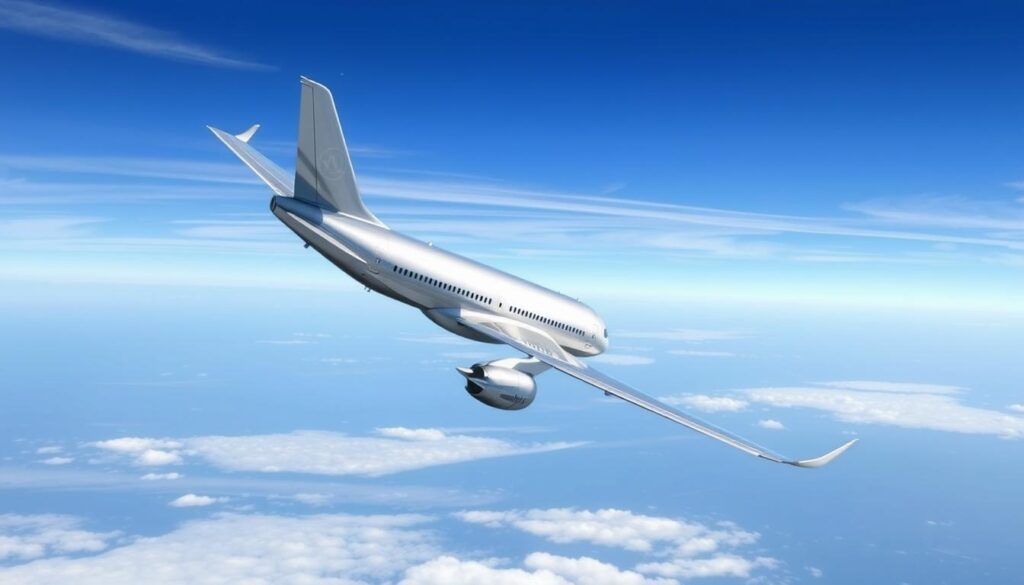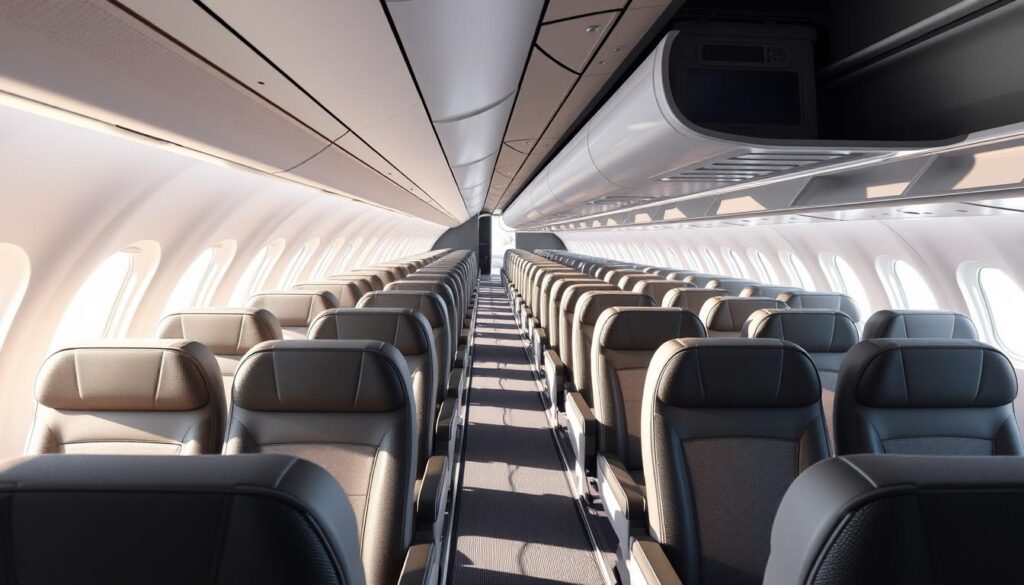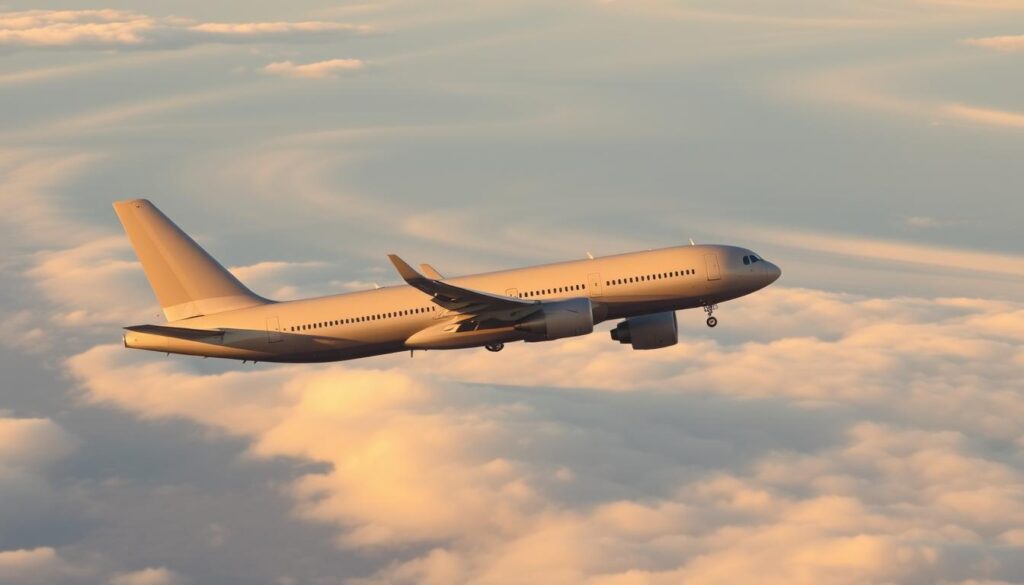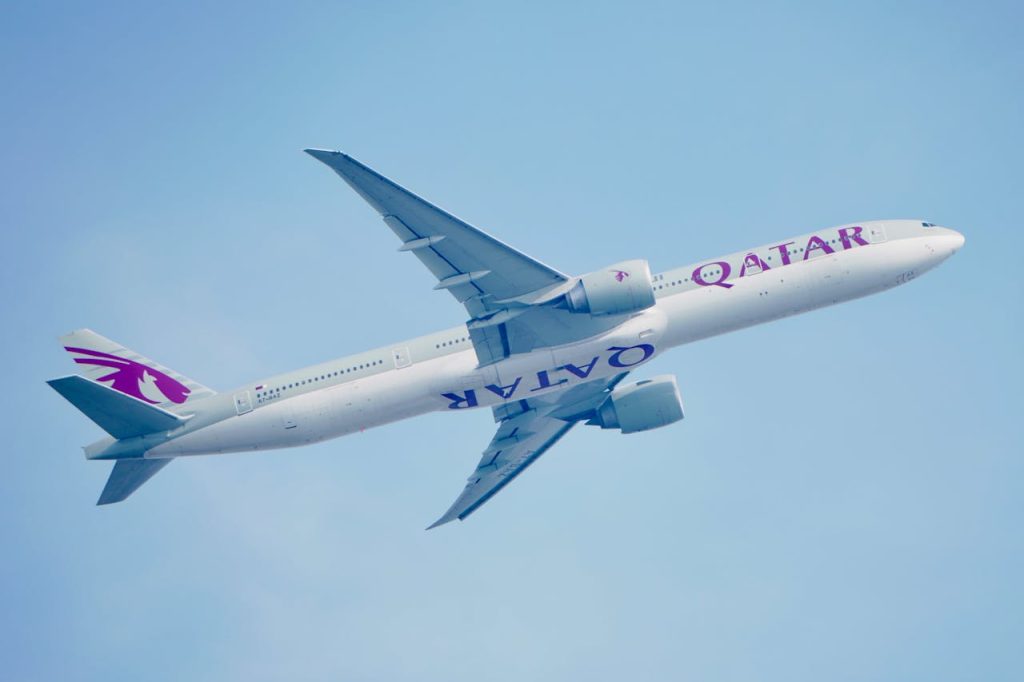The Boeing 757-300 can hold up to 280 passengers in one class. This huge capacity has made it a big player in the world of planes. It meets both people and cargo needs.
We’ll dive into its history, details, and the big role it plays in flying. This jet is not only known for its looks and how it works. Its ability to adapt has kept it important in the market.
Key Takeaways
- The BOEING 757-300 can accommodate up to 280 passengers.
- This aircraft variant is known for its extensive range capabilities.
- It plays a significant role in both passenger transport and cargo operations.
- The BOEING 757-300 is a popular choice among airlines for its operational versatility.
- Understanding its specifications enhances appreciation of its contributions to commercial aviation.
Introduction to Boeing Aircraft
Since 1916, Boeing has been a giant in aviation. They’ve led with groundbreaking planes and jets that set new standards. Their craft are known for being innovative, safe, and dependable.
Boeing’s journey in making aircraft showcases a commitment to top-notch engineering. They have rolled out various models to meet the aviation industry’s needs. This has helped airlines improve their services and expand their fleets.
Looking at Boeing’s impact, it’s clear they’ve adapted well to what the market needs. Their ability to change has made them an aerospace leader. They continue to shape the future of air travel with their advancements.
Historical Background of the Boeing 757 Family
The Boeing 757 family marks a big moment in aviation history. It appeared in the early 1980s. Airlines were looking for planes that used less fuel but could still fly far. So, Boeing made the 757 to follow the 727. It had better aerodynamics and engines.
Studying the Boeing 757 family, we find important steps in its development. It was made to be flexible and efficient. This made it popular worldwide. The 757-200 and 757-300 models are key to many airlines today. They show a move towards planes that are both strong and comfy for passengers.
Learning about the Boeing 757’s past helps us see its role in flying history. Every improvement shows Boeing’s focus on new ideas. It also hints at what planes might look like in the future. This tells us how aviation keeps changing.
| Year | Event | Significance |
|---|---|---|
| 1981 | First flight of Boeing 757 | Marked the entry of a new aircraft designed for efficiency |
| 1983 | Boeing 757 enters service | Signaled the beginning of its operational use by airlines |
| 1990 | Introduction of Boeing 757-200 and -300 | Diversified options for airlines to cater to different range and capacity needs |
| 2003 | Last Boeing 757 officially delivered | Concluded a significant era while leaving a lasting legacy in aviation history |
The Creation of the Boeing 757
The Boeing 757’s creation was a major step in air travel, starting in the late 1970s. It aimed to be better than the older Boeing 727. Through hard work and new ideas, the goal was to cater to more passengers and be more efficient.
The launch on February 19, 1982, was a big deal for Boeing. It showed off new tech like the supercritical wing and light materials. These improvements made the plane use less fuel and fly better, making the 757 a top choice.
When the 757 started flying in 1983, both airlines and travelers loved it. It stood out for being comfortable and reliable. We are really proud of it because it shows our dedication to leading and improving airplane design.
BOEING 757-300: Specifications and Features
The BOEING 757-300 is a standout in the aviation world. It’s an extended version of the 757 family, which means more room for passengers. It keeps up its top performance too. Let’s take a closer look at its engines and sizes that make it a top pick for airlines.
Engine Types and Performance
There are two powerful engines to choose from for this model. Airlines can go with either the Pratt & Whitney PW2043 or the Rolls-Royce RB211-535E4. Each engine option provides a lot of power, very important for a smooth takeoff and flight. The engines can push up to 43,000 pounds of force, letting the plane cruise at 530 mph. With a max distance of 3,400 nautical miles, it’s great for long trips. That’s why the BOEING 757-300 is a favorite for flying far.
Dimensions and Capacity
The 757-300 is big, at 178.5 feet long, which means it can take up to 243 passengers. Its wings stretch about 124 feet across. This not only helps the plane fly smoothly but also makes the inside feel roomy. These plus points help the BOEING 757-300 offer both great performance and comfort for its passengers.
The Boeing 757-300 vs. Other Variants
When looking at the Boeing 757-300 and the Boeing 757-200, we see some big differences. Knowing what sets these two apart helps in choosing the right setup for passengers and cargo.
Comparative Analysis with Boeing 757-200
The Boeing 757-300 has more room than the 757-200. The 757-200 fits about 200 passengers, but the 757-300 can take up to 250. This makes the 757-300 a great choice for airlines that need extra seats on full flights.
Its longer body means more tickets sold on each trip. Airlines focusing on packed routes can really benefit from this.
Passenger and Cargo Configurations
The Boeing 757-300 is versatile in seating and cargo setups. Airlines can change the interior to match what their travelers need. This is a big win over the 757-200, which doesn’t offer as many layout choices.
For moving goods, the 757-300’s extra space is perfect. It fits larger items without sacrificing room for passengers.
In the end, comparing the Boeing 757-300 and 757-200 shows clear differences in size and adaptability. Each version fits different airline needs, showing the range of options in the aviation world.
Boeing 757-300 Range Capabilities
The Boeing 757-300 is well-known for its long reach. It can fly for about 3,400 nautical miles. This lets it serve many long-distance routes well. It does this without giving up comfort or space for bags.
This jet can also take off from shorter runways. This means it can fly to and from many airports, big or small. This makes it very useful for airlines, letting them serve various places.
The Boeing 757-300 is versatile, good for both short and long trips. This helps airlines offer more options and stay competitive.

Aircraft Interior and Comfort Features
In the Boeing 757-300 interior, comfort meets modern design. It’s made for today’s traveler. Ergonomic seats and smart cabin layouts increase comfort. Every detail aims to make your journey better.
This plane uses space well. It has enough room for your legs. Overhead bins are big, so your things stay out of the way. You get nice extras like adjustable headrests and power outlets too.
The plane is also pretty quiet. It uses special stuff to keep cabin noise down. So, it’s easier to rest or enjoy your time flying. This makes your trip much nicer.
The cabin looks good and feels current. Lighting can change to make things cozier. You can adjust it to suit what you like. The Boeing 757-300 shows how good design can make flying nicer.
Common Seating Configurations on the Boeing 757-300
Airlines choose different seating plans for the Boeing 757-300. They do this to meet the needs of their routes and customers. They can mix different classes to serve all passengers well while keeping flights profitable.

| Class | Number of Seats |
|---|---|
| First Class | 24 |
| Main Cabin | 210 (32 Comfort+) |
This design lets the plane hold 234 passengers, making sure everyone is comfy. It gives people choices, like Comfort+ seats for more legroom. This way, every traveler can find something they like.
Airlines change their seat plans to meet everyone’s needs. This way, they can stay up-to-date with what travelers want. This makes sure our flights are not just smooth, but also just right for us. You can learn more about Delta’s seat plans through this link.
Usage in the Airline Fleet
The Boeing 757-300 is a key player in airline fleets worldwide. A few airlines still use this adaptable aircraft. It showcases its flexibility and charm in the world of flying.
Current Operators of the Boeing 757-300
In 2023, Delta Air Lines, United Airlines, Condor, and Icelandair are major users. They leverage the 757-300’s strengths for their specific flight plans and needs. Its ability to handle medium and select long-haul trips makes it perfect for linking less-served cities.
Global Reach and Availability
The Boeing 757-300 continues to prove its value in worldwide aviation. It offers performance benefits that meet Boeing 757-300 users’ demands, enabling affordable flights in a tough market. As airlines aim for excellence and happy passengers, the 757-300 fits right in with their plans and what travelers want.
The Impact of the Boeing 757 on Commercial Aviation
The Boeing 757 drastically changed the aviation industry since it first came out. It moved away from older models to use less fuel and have two engines. Looking at its effect, we find big improvements in how planes work and how safe they are.
This plane played a key part in growing commercial flying. It worked well for flights that weren’t too short or too long. This made it a hit with airlines all over. The 757 was dependable and made trips better for passengers. It set new standards for what flyers expect.
The 757’s importance is huge. Airlines and companies that lease planes love it, showing how popular it is worldwide. It tackled issues like the cost of fuel going up and the need for greener flying. The Boeing 757 sets high standards in airplane technology.
Conclusion
As we wrap up our look at the Boeing 757-300, we see it as an engineering marvel. It has made a huge impact on the world of flying. This plane stands out for its amazing ability to do many tasks well and fly like a champ.
Today, many airlines love the Boeing 757-300 for its dependability and how comfortable it is for passengers. It fits perfectly into various airline fleets, tackling today’s travel needs with ease. The Boeing 757-300’s story doesn’t end, even after production stopped in 2004.
Reflecting on this incredible plane, we see its importance in aviation history and its influence on travel today. the Boeing 757-300 perfectly mixes past success with future goals. This keeps it a key part of the story of flying.


